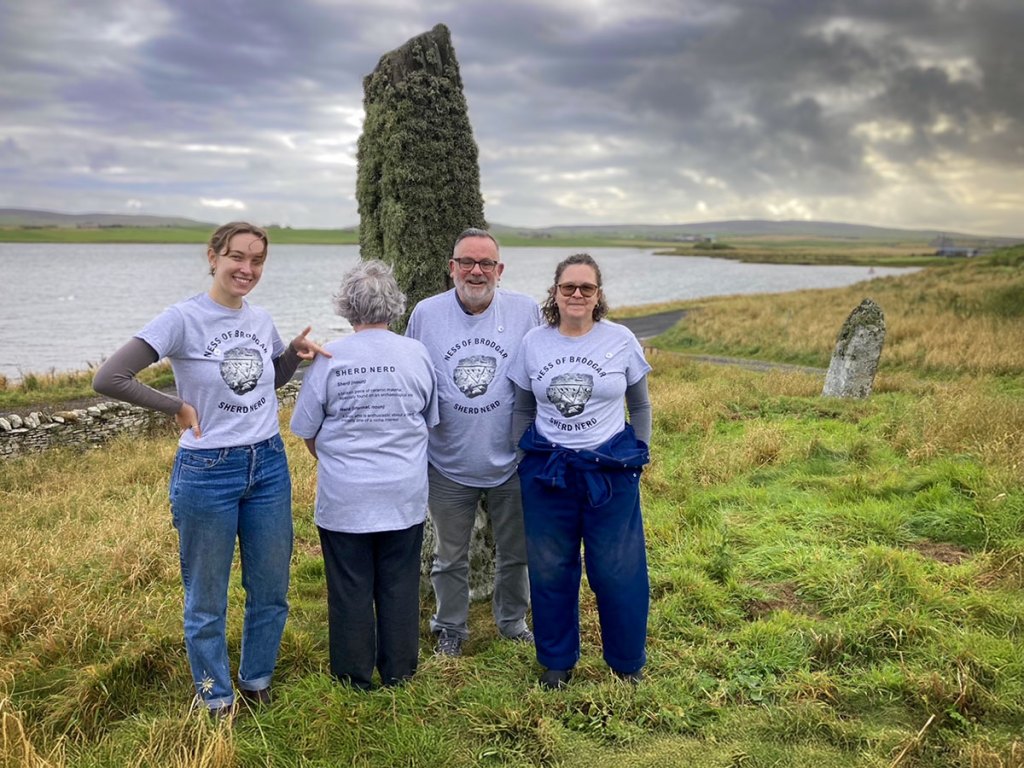Sherd nerd life – a clay portal to the past and a lottery win

By Huw Williams
It’s funny, the things you think about as you fall asleep. The other night I found myself wondering if I’d rather win the lottery, or find a Neolithic fingerprint preserved in the clay of a five-thousand-year-old pot.
They might both seem like vanishingly small chances. Except that, for the past few weeks, I’ve been part of a small team – the self confessed “Sherd Nerds” – cleaning and appraising just some of the more than one hundred thousand pieces of prehistoric pottery excavated at the Ness of Brodgar over the past 20 years and more.
Archaeologists said when digging stopped at the site last summer that it wasn’t the end of the story of the Ness. That they still had years – decades – of work to do, processing and preparing to publish all their finds.
The project to triage ceramics is a tiny part of that.
We sift through the boxes and boxes and boxes of pottery finds, recovered and listed over the decades, to find and highlight the ones that need closer examination by specialists.
Some of them turn out to be carefully curated chunks of mud that crumble to dust as you investigate them.

Many of them are apparently humdrum pieces of red, grey or yellow fired clay, no more than a centimetre or so square. Though even they, of course, are valuable and will play their part in long-term research. We’re still learning new things about Skara Brae, after all, and that was first uncovered in 1850. So who knows what secrets new scientific techniques will uncover in the future, from even the most uninspiring remnants.
But a few of the pieces are beautiful, highly decorated, and obviously exciting.
A tiny number have the impressed marks of fabric or basket weave left in the damp clay before it was fired. Literally in the fire. No kilns at the Ness at that time.
And I did find the fingerprint I wanted.
Left when the maker smoothed the rim of their pot.
Tiny. But quite distinct.

And it’s those artefacts that turn pieces of clay into portals to the past. Establishing a direct connection with the people who made them 50 centuries ago.
Sometimes it isn’t even the most finely decorated pots that are the most powerful.
Just a few days ago I unwrapped two sherds (broken pieces of ceramic material found on an archaeological site) that together just about covered the palm of my hand.
Near the top, on what would have been the inside of the vessel, were two parallel lines, with decoration stabbed between them – perhaps with the end of a feather or small stick.
It’s a style you see quite often. But this time the lines were wobbly. The decoration was a bit random.
That didn’t spoil them. If anything, it made me love them more.
You could picture the potter. Perhaps an apprentice, inexperienced child, or older person whose eyesight wasn’t as sharp as it had been or whose hands weren’t perfectly steady anymore.
And, maybe, their mentor standing next to them, nodding wisely. Knowing this pot wasn’t perfect. But deciding not to crumple it back to clay, and sending it to the fire anyway.




Sometimes as we clean a fragment – with watercolourists’ brushes and porcupine quills (yes, really – quills from actual porcupines) it will disintegrate. It was only the dried mud (or “midden”) which we are removing that held it together.
When that happens another volunteer, or one of the archaeologists, will say something reassuring like “don’t worry – that piece probably wasn’t going to transform our understanding of the Neolithic.”

But there is so much pot recovered from the Ness that the collection as a whole will probably do just that.
At the briefing for volunteers at the start of the project, site co-director Anne Mitchell told us that by the end of the work each of us would probably have handled as much stone age ceramics as most professional archaeologists get to see in a lifetime.
I know my joy at all this makes me fairly and squarely a nerd (a person who is enthusiastic about a subject, especially one of niche interest),
But. I found a fingerprint left in clay five thousand years ago. So, I don’t care.
And, as it turned out, later on the same Wednesday morning I logged on to my emails.
There was a message from the National Lottery.
I had won a prize in the Euromillions draw the night before.
A glorious two pounds and 80 pence.
I didn’t have to choose after all.














